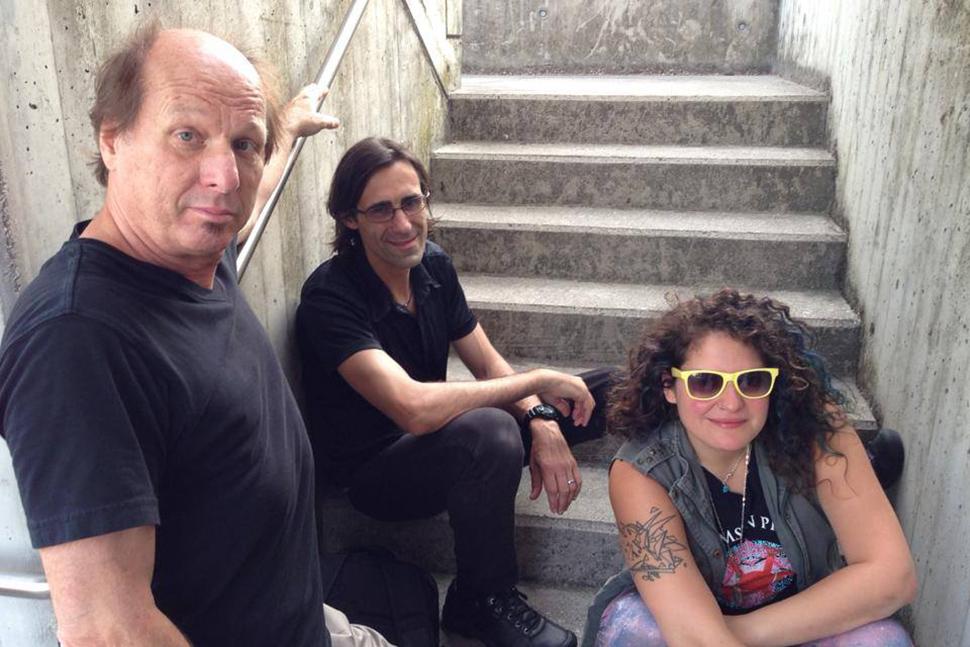
“The reason we call it Flux music is because you never get the same thing out of it twice.”
Anytime someone refers to “angular guitar sounds,” they’re not necessarily being overtly pretentious or deliberately obtuse — they’re more than likely trying to describe the signature tone that’s been perfected by one Adrian Belew, the master axman who’s stamped his signature style all over aurally challenging songs by artists like Frank Zappa, Paul Simon, David Bowie, Talking Heads, and Nine Inch Nails. But Belew may be best known for the 33 years he gave to the ever-progressive collective known as King Crimson, conjuring up a variety of stimulating high-quality sonics from the sophisticated wordplay surrounding the caterwaul of “Elephant Talk” to the exquisite enmeshing of verses in 6/8 with choruses in 7/8 on “Three of a Perfect Pair” to the not-so-simple routines described in the, well, perfectly angular “Sex Sleep Eat Drink Dream.”
“The Flux:FX app is going to be super high-quality, a great audio processor with over 30 effects in it.”
But now, Belew has his own iOS app called Flux:FX, subtitled “Music that is never the same twice.” And that’s exactly right. Flux is comprised of hundreds of songs, pieces of music, and sonic “snippets” culled from Belew’s deep personal music library, buttressed by engaging visuals developed by MobGen (an Amsterdam-based design agency) that randomly change with the music. Flux also includes pictures, lyrics, studio notes, backstories about the songs, and interactive ways to share the Flux experience on social media. Projected to launch Thanksgiving week, Flux will run you $10 for iPhone and iPad usage. (Flux for Android is in development.)
Flux was funded via a Kickstarter campaign that raised over $35,000 — well above the mere $100 that was Belew’s stated goal. Why such a low target? “Because I’m crazy,” he jokes. (Dig me, but don’t bury me!)
Belew, 64, called Digital Trends during a break in his current 40-date Adrian Belew Power Trio tour to further explain the capacity of Flux, theorize if albums still matter in the digital age, and share what the best lineup configuration for live improvisation is.
Digital Trends: What’s the story behind the name Flux?

Adrian Belew: The reason we call it Flux music is because you never get the same thing out of it twice. That’s not what it’s supposed to do. It’s not like, “Hey, I want some new effects so that when I go to them, they’ll sound the same every time.” Here’s another delay, here’s another flanger! It’s not that at all. You can never position your finger on the screen and get back what you did exactly. Every time you go to a preset, it’s going to be something a little different.
This is something I’ve wanted to do for a long, long, long, long time. It’s a music app with all new music from me — songs and musical pieces that include lots of sounds, loops, sound effects, and common everyday noises. What happens in Flux is that all of the music and information is short. You may have, every now and then, a full song, but most of the time, you’ll hear a portion of the song. And then the next time you hear it, you may hear a different portion of it, or a different mix of it. Over time, you get to know the music, because it’s a big musical jigsaw puzzle. Every time you press the play button, you also get visuals that go with the music, and they’re never the same visuals either.
“It’s hard to listen to another full record nowadays. After about the first chorus, I’m ready for the next thing.”
The snippets are sounds that “interrupt” the music. A song might be playing, and at any point, it will get in interrupted by something else — it could be the sound of a telephone ringing, or somebody laughing, or a guitar effect. All of those things are snippets — very quick, short, and usually no longer than 17 seconds at the most. They lead you right into the next thing, which is how Flux ends up being different every time.
The app comes with lots of information — you can press a favorite button, and whatever that is goes into a playlist so you can hear it anytime you want if you don’t want to wait around for it to randomly come back. It’s a music app you can probably return to hundreds of times, and really still never exhaust it.
If you get new ideas, will you add them into the Flux library?
Yeah, that’s the thing about Flux that separates it from any other recording — it’s never finished. I have a content management system here where I can upload new images, new sounds, new pieces of music, and new songs. I can change what’s there. The idea is that it continues. For me, it’s a new artistic platform. I see myself in the future continuing to add a lot of cool new stuff into this Flux stream. I like it because I can utilize so many of my ideas that I used to have to abandon when I had to write 12 songs for an album. (chuckles)
Right, now you can use every idea, no matter how short it may be. That said, do you see a future for the full-length album?
I still plan to go the regular record route as well, because I do have some material that’s not short. The ideas in Flux are all short, or they have been shortened, because to keep the flow of it so quick and surprising, you can’t put in a 5-minute piece of music.
But it’s hard to listen to another full record nowadays. After about the first chorus, I’m ready for the next thing. (chuckles) And that’s in keeping with the way of the world — now, people get their information from the Internet and TV in quick, random, short bursts. In the music world, there’s nothing really like that. In music, we’re using the same exact format we used 50-60 years ago — 3-, 4-, or 5-minute songs with a verse, a chorus, a verse, etc., etc. So I think that Flux is for people like myself who have a short attention span.
“I think that Flux is for people like myself who have a short attention span. “
I like that! For younger people or people like I am at my age — we like to get more information quicker.
Quality wise, what’s the bit rate for these recordings? Did you have to compress them at all?
We always try to make the highest quality recordings ever, but we did have to compress them a bit. Otherwise, you’d have this huge download to deal with. What we’re using is AAC [Advanced Audio Coding], which we hope is a better delivery method, and higher than MP3 quality. [AAC files feature lossy digital compression considered to be a step up from MP3s at similar bit rates.] When you’ve got hundreds of songs plus visual and text information — it’s a large download, but not too large.
And I’ll be adding stuff as time moves on. I could see myself adding, say, another half-hour’s worth of stuff. It’ll grow on its own, but we want to make sure when it first hits your device, you don’t sit there forever waiting for it. It’s really exciting when you see it on your phone — the reaction is, “Wow, I’ve never seen anything like this before.”

How do you incorporate the Flux concept into your live Power Trio sets?
I’ve talked to my fans on Facebook for so long now, and I’ve realized they want to hear some of the stuff we have not played in years and years — stuff from the early solo records, so I’m dipping back into my old catalog and digging a little deeper into the tracks. In thinking about how to do that, I didn’t want to do all of them as whole songs, because that would take up the whole concert. So we’ve dropped 30 different tracks in the show. Sometimes they’re the full thing, sometimes they’re Flux’ed. We’ll be playing along, and suddenly, vrrrroop — something else happens, and some of the snippets will be played. I have a way to trigger them. And so the band just rips through 10 songs in about 20 minutes. (laughs heartily)
It’s really cool, because the show is exciting and it’s fast-paced, and you don’t know what to expect. Well, we do, but you don’t. It’s a way of reminding people of all of the different music I’ve been a part of without having to beat them over the head with it. If we have something that’s too good to cut any shorter, then we don’t cut it any shorter, of course. Sometimes you could play a verse, a chorus, a verse, and then boom — we’re on to the next thing. These nice, connecting moments, these snippets — they’re interesting. You go, “Wow, what is that sound? Where did that come from?” It’s fast-paced and difficult to do.
Do you make game time decisions where one night you’ll Flux one thing, and then Flux something else another night?
Yeah, we can do that because in my computer — the laptop that’s a part of my guitar rig — I have a whole list of snippets that I can choose from, and I can kind of signal everyone, “Boop! Here we go!” (laughs) Then we play it, and then we’ll count back into the next thing.
What laptop are you using on tour?
It’s an Apple, the latest MacBook Pro. Eventually I’ll use an iPad, because I have a second app that comes out soon called Flux:FX, which is an audio processor that just mangles any sound you put into it. It’s like an XY Pad or a Kaoss pad, and you can use your finger to really change the sound of what you’re doing. Once I get the new iPad, we’ll incorporate that into the show. It’ll be there right in front of me, probably attached to my mic stand. Say I’m playing a guitar solo — I’ll lean over and noodle with it and create some wacky guitar sounds.
“It’ll be great for a DJ, producer, drummer, keyboard player, or singer.”
The Flux:FX app is going to be super high-quality, a great audio processor with over 30 effects in it. You can use the XY area to combine all these different effects and have hundreds of different parameters at the same time using your fingertip. As you’re moving your finger around, you’re not just changing one effect; you’re changing all kinds of things at the same time.
The cool thing about it is it’s not really for guitar exclusively — you can put anything through it. It’ll be great for a DJ, producer, drummer, keyboard player, or singer. It’s easy if you just want to use our presets, as there will be several hundred of those. But if you want to get into something you can really dig into deeply, you’ll be able to spend hundreds of hours of your life with this one. (laughs)
In a way, Flux mirrors what you’ve always done live with that special element of improv you bring to every show of yours I’ve seen. You’re never playing any of your own material the same way twice, that’s for sure.
Well, with a live performance, I feel a certain aspect of it should be the same. Obviously, there are arrangements that are going to be the same, but I also always like to build in surprise elements and improv. That way, it keeps it fresh for the band and for anyone who comes to more than one show. It keeps the fun in there. If there are some portions of the evening where you’re not absolutely sure (laughs)…
How do you see the tour evolving over the course of 40 shows?

I can’t even imagine what we’re going to sound like come date 40. (laughs) It could morph into something totally different by then end of a tour that long, yes. And we play many nights in a row, so the energy level and the symbiosis that happens between players — you don’t have that much time to think; you’re just going to be doing it.
That’s why I go see live shows. Yeah, there’s a built-in song framework to some degree, but I don’t want to see something played exactly how I heard it on the record.
No, not at all! If you want to do that, just turn up your record and have a party in your backyard. (both laugh) But it happens with us naturally since we’re a power trio playing a lot of material that was never meant to be played by a trio. We’ve already abstracted the material into something different, and that’s what I love about the power trio. Being a trio lends itself better than any other lineup I can think of to improv, because you have three people looking at each other, reading each other’s musical thoughts, and moving in sync together — or against each other. It’s a little easier to improv as a trio, I think.







